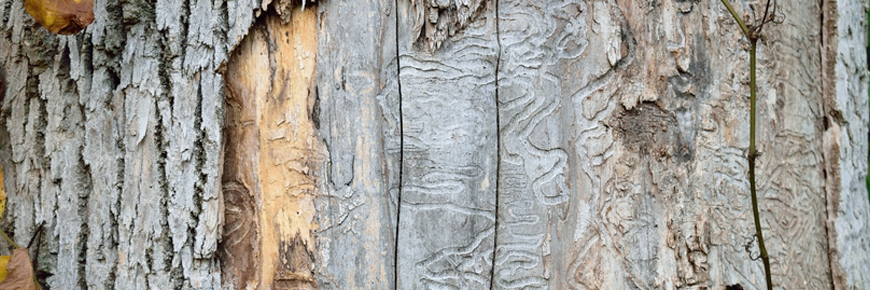
Non-native species
Rouge National Urban Park
Effects of Invasive Species
Several invasive species are a problem in Rouge National Urban Park. It is important to understand the key characteristics of non-native species, and what we can do to minimize their effects on park ecosystems.
Invasive species are non-native species that have been introduced into the local ecosystem, usually through human activity. Some invasive species (especially plants) were intentionally brought over from Europe or Asia for gardening or pest control purposes. For example, garlic mustard was introduced by European settlers to use as an edible herb. Other invasives have been introduced accidentally as stowaways in materials imported from other parts of the world. There are several characteristics that many invasive species share:
They can out-compete native species
Many invasive species are able to grow earlier and/or faster than native species, giving them an advantage in securing nutrients and habitat. Some species also have other strategies to help them out-compete native species, such as shading-out other plants or secreting toxic chemicals that inhibit the growth of other species.
They can live in a wide variety of conditions
Invasives are generalist species, meaning they are able to survive in a wide range of conditions. Species that are invasive to Ontario are able to survive our winters, along with all other climate conditions that we experience. Removing invasive species from a habitat tends to be extremely difficult because of their strong survival abilities.
They are able to reproduce and spread aggressively
Invasive species can often produce a large number of offspring in a very short amount of time, which allows them to quickly take over an area. Invasives can also easily spread and establish new populations. For example, invasive plants often produce large quantities of seeds, allowing them to spread aggressively, while some invasive insects can travel great distances by flight.
They have no natural predators
When invasive species are introduced into a foreign habitat, their natural predators and competitors are no longer present, allowing them to grow and reproduce with few threats. Without natural predators to keep their populations in check, invasives can quickly start to spread out of control.
What can you do to help?
- Stay on trails to avoid spreading seeds from invasive plant species found off trail
- Do not release any pets, plants, or fish bait into the park
- Learn how to identify invasive species and report where you see them
- Use local firewood when camping to avoid accidentally transporting invasives to new locations
Common Invasive Species
Invasive species are problematic because they can out-compete native species and take over ecosystems. Parks Canada is working on controlling invasive species in Rouge National Urban Park.
Emerald Ash Borer

The emerald ash borer is a beetle native to Asia that has attacked and killed millions of ash trees in North America. It was first detected in Canada in 2002 and is believed to have been accidentally introduced through wooden packaging material. The beetles lay their eggs on ash trees and the larvae chew through the bark and feed on the tree's water and nutrient transport system, killing it. The range of the emerald ash borer is rapidly expanding due to the movement of infested materials. Help stop the spread of this destructive species by not transporting infested wood and burning firewood where you obtain it.
Dog-strangling Vine

The name dog-strangling vine (DSV) refers to two highly invasive plants, black swallowwort and pale swallowwort, both native to Eurasia. DSV was introduced to the northeastern United States for use in gardens in the mid-1800s. It spread to Ontario in the late 1800s and has since become a major issue in many areas. The plant forms dense stands that crowd out native plants and young trees, decreasing biodiversity. It produces large numbers of seeds and can also grow from root fragments, making it difficult to eradicate. DSV is a member of the milkweed family and its resemblance to milkweed makes it a threat to monarch butterflies. The butterflies will lay their eggs on DSV, but the larvae do not survive, as monarch caterpillars only feed on milkweed.
Phragmites (Common Reed)

Invasive Phragmites is a perennial grass native to Eurasia that grows around wetlands and beaches. It forms dense stands, reaching heights of up to 5 metres, and spreads aggressively, crowding out native vegetation and reducing plant biodiversity. It releases toxins from its roots to hinder the growth of surrounding plants, helping it to take over an area. Compared to native wetland plant communities, stands of invasive Phragmites offer poor habitat and food for wildlife.
Garlic Mustard

This invasive plant was introduced from Europe in the early 1800s for use as an edible herb. It is an aggressive forest invader and can displace native wildflowers and threaten species at risk such as drooping trillium, white wood aster, wild hyacinth, and wood poppy. Garlic mustard grows a short cluster of leaves in its first year of growth, then produces a taller stem with flowers and seeds in its second year. The leaves have a strong garlic smell when crushed. Garlic mustard can grow in a wide range of sun conditions and its seeds remain viable in the soil for up to 30 years, making it difficult to remove from an affected area.
Red-eared Slider

Red-eared sliders are a type of turtle commonly kept as pets. Native to the southeastern United States and Mexico, these turtles have been introduced into Ontario by pet owners releasing them into the wild. Red-eared sliders compete with native turtle species for food and habitat, often crowding them out and taking over wetlands. This puts additional stress on native turtle populations, many of which are already under threat from habitat loss, road deaths, and poaching.
Related links
- Date modified :